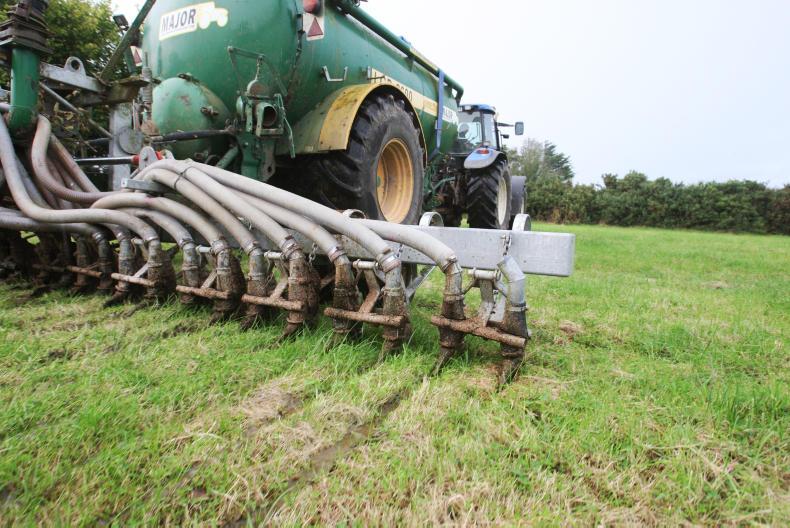The scale of the challenge that NI agriculture faces in reducing ammonia emissions has been made clear by new research.
According to AFBI scientists, a range of measures could be implemented on NI farms within 5-10 years which would cut total ammonia emissions by 25%, and lead to “significant improvements” in nitrogen levels at environmentally designated sites.
However, AFBI analysis suggests that it would still mean that only 16 out of 241 sites would be brought into favourable status.
Speaking at an online event last Thursday Dr John McIlroy from AFBI said that achieving further improvements will require the development of new ammonia reduction technologies.
“These solutions would come from further scientific research into, for example, dietary strategies, slurry treatments, agro-forestry and tree shelter belts, novel livestock housing systems and novel slurry land spreading systems,” McIlroy said.
Critical load
At present, 98% of priority habitats in NI are above the “critical load” for ammonia and agriculture is responsible for 96% of emissions in NI.
The measures that would achieve the initial 25% cut in ammonia emissions require significant change at farm level, and include no longer spreading any slurry with splash plates. Instead, the AFBI calculations are based on half of all slurry in NI being applied by trailing shoe spreaders and the other half by dribble bars.
The plan also involves replacing all unprotected urea fertiliser with stabilised urea, and extending the grazing season for cattle by two weeks each year.
The researchers allowed for a “moderate uptake” of low crude protein diets and genetic improvement to lower nitrogen excretion from livestock.
More expensive measures, such as slurry store covers and floor systems to limit the mixing of urine and dung, are projected to have a “lower uptake”.
Emission calculations
AFBI scientists have also been examining how ammonia levels in NI are calculated. Emissions are currently based on data from three monitoring stations, as well as scientific models that are applied to other data, including livestock numbers and fertiliser usage.
As part of the ongoing research, 28 new monitoring stations have been set up across NI to compare the current system of calculating emissions with actual levels of ammonia locally.
“To date, we have collected nine months of data from the network – there is a good agreement between the models and the measured ammonia concentrations regionally, although we need to capture data for at least a year before we can fully validate the model’s outputs,” McIlroy said.
The research will be used by DAERA in developing a new “ammonia action plan” for NI agriculture. The department has previously said that proposals for on-farm measures to reduce emissions will be put out for public consultation later this year.
Read more
Protected urea - questions answered
Minister to decide ammonia rules
The scale of the challenge that NI agriculture faces in reducing ammonia emissions has been made clear by new research.
According to AFBI scientists, a range of measures could be implemented on NI farms within 5-10 years which would cut total ammonia emissions by 25%, and lead to “significant improvements” in nitrogen levels at environmentally designated sites.
However, AFBI analysis suggests that it would still mean that only 16 out of 241 sites would be brought into favourable status.
Speaking at an online event last Thursday Dr John McIlroy from AFBI said that achieving further improvements will require the development of new ammonia reduction technologies.
“These solutions would come from further scientific research into, for example, dietary strategies, slurry treatments, agro-forestry and tree shelter belts, novel livestock housing systems and novel slurry land spreading systems,” McIlroy said.
Critical load
At present, 98% of priority habitats in NI are above the “critical load” for ammonia and agriculture is responsible for 96% of emissions in NI.
The measures that would achieve the initial 25% cut in ammonia emissions require significant change at farm level, and include no longer spreading any slurry with splash plates. Instead, the AFBI calculations are based on half of all slurry in NI being applied by trailing shoe spreaders and the other half by dribble bars.
The plan also involves replacing all unprotected urea fertiliser with stabilised urea, and extending the grazing season for cattle by two weeks each year.
The researchers allowed for a “moderate uptake” of low crude protein diets and genetic improvement to lower nitrogen excretion from livestock.
More expensive measures, such as slurry store covers and floor systems to limit the mixing of urine and dung, are projected to have a “lower uptake”.
Emission calculations
AFBI scientists have also been examining how ammonia levels in NI are calculated. Emissions are currently based on data from three monitoring stations, as well as scientific models that are applied to other data, including livestock numbers and fertiliser usage.
As part of the ongoing research, 28 new monitoring stations have been set up across NI to compare the current system of calculating emissions with actual levels of ammonia locally.
“To date, we have collected nine months of data from the network – there is a good agreement between the models and the measured ammonia concentrations regionally, although we need to capture data for at least a year before we can fully validate the model’s outputs,” McIlroy said.
The research will be used by DAERA in developing a new “ammonia action plan” for NI agriculture. The department has previously said that proposals for on-farm measures to reduce emissions will be put out for public consultation later this year.
Read more
Protected urea - questions answered
Minister to decide ammonia rules






 This is a subscriber-only article
This is a subscriber-only article










SHARING OPTIONS: